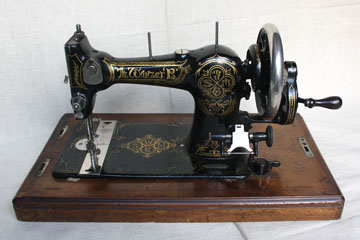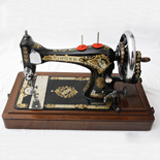R. M. Wanzer Sewing Machines
Richard Mott Wanzer started with a small factory in Buffalo, New York making copies of Singer machines, but in 1860 he relocated to Hamilton, Ontario in Canada where he established R.M Wanzer & Co. Initially he continued to make copies of Singer and Wheeler & Wilson machines, but then in 1862 he introduced his own 'Family Shuttle Machine' incorporating features from both the Singer and W&W designs.
Wanzer's second design was a completely original lockstitch machine called the 'Little Wanzer'. It was unusual in having the boat shuttle move in a vertical arc and also for being mounted on a marble slab. It's small size and low price (C$ 25 for the hand machine) made it an instant success and over 4000 were sold in the first year. Easrly examples of the Little Wanzer didnt have a cover over the needelbar mechansism and had simple 5 spoke balance wheels. Later versions has a nickel plated cover over the needlebar and a more elaborate balance wheel. By 1874 200,000 had been made and they were being widely exported to Europe.
In the late 1870's the 'New Little Wanzer' had a fully enclosed needle bar and a patented take-up lever.
In 1874 Wanzer expanded its range of sewing machines to include four new models
The Wanzer A was similar in construction to the Little Wanzer and available as a hand crank or on a treadle stand.
The Wanzer D was a heavy duty industrai model for tailoring.
The Wanzer E was a heavy duty wheel fed industrial model for leather and boots.
The Wanzer F was the most successful of the new models and went on to sell in large numbers. It was a treadle operated machine with heavy castings that enclosed the working parts. It featured a reversible feed, which enabled the operator to sew both forwards and backwards without stopping the machine.
The Wanzer B was a vibrating shuttle machine with a curved open boat type shuttle.
The last domestic model made by Wanzer was the Wanzer C Light Foot Family machine, which was introduced around 1879. Loosely based on the Wanzer F, the Wanzer C featured a triangular needle bar, a self-threading shuttle, and an automatic bobbin winder.
By the later 1880's the company was suffering from a sharp drop in demand due to the recession in world trade. In 1890 production stopped and the company was closed.

Wanzer B (Improved)
Serial #106426
